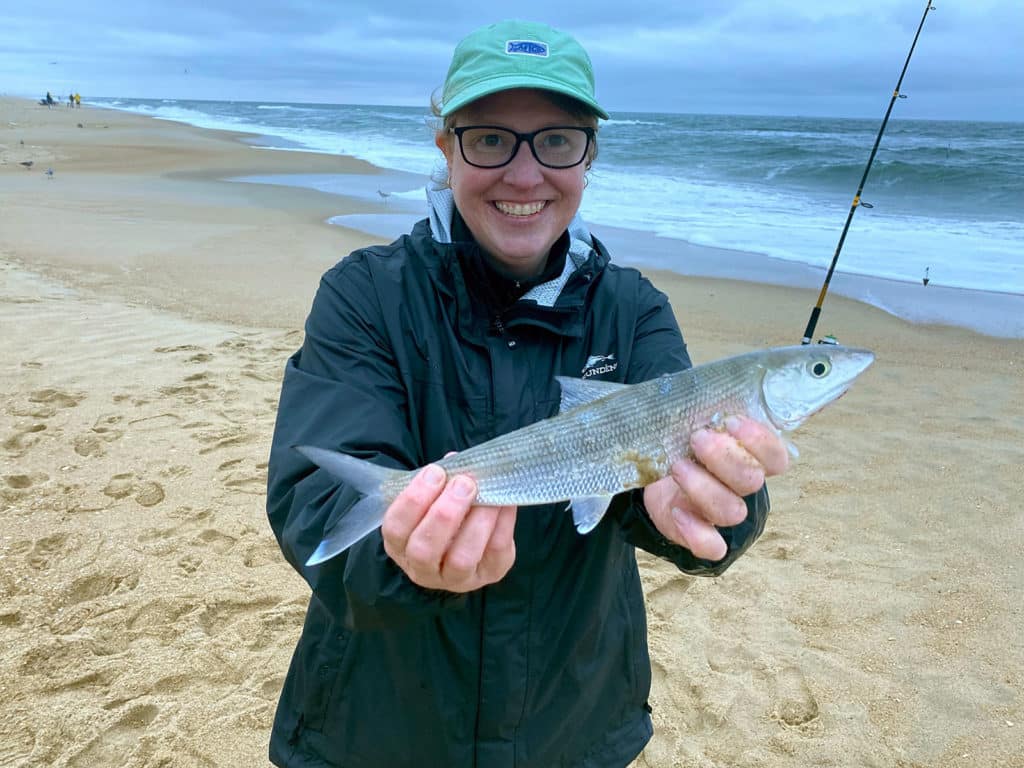
Tonya Pell was surf fishing the beaches of South Nags Head, North Carolina, in late October as part of her honeymoon when she caught a fish she didn’t recognize. Unknown to her at the time, she had landed a prized bonefish that’s much more common in tropical and subtropical waters.
Pell, who lives in West Virginia, visits the Outer Banks islands a couple times a year, but her usual fishing targets include species such as red drum.
“I have been fishing that same stretch of beach for over 30 years,” said Pell. “Once I saw the fish, it was a surprise; I had no idea what was in front of me. It was about 14 inches long and like nothing I had ever seen before.”
Rare Bonefish Visitor
Anglers fishing in the Florida Keys, the Bahamas or Bermuda might be familiar with bonefish, but to catch a silver ghost in North Carolina is unusual.
“If angler reports are any indication, bonefish in North Carolina are rare,” said Dr. Aaron Adams, Bonefish & Tarpon Trust’s Director of Science and Conservation. “I am aware of a juvenile being caught in Long Island Sound, likely transported there as larvae. And there have been a few reports of larger adult bonefish as far north as New Jersey and New York, but it still does not appear to be common.”
North Carolina does not currently have or keep state record catches for bonefish. Further, bonefish are not a qualifying fish for North Carolina’s citation program.
Pell was fishing with a 10-foot surf rod and 5000-size reel spooled with mono. At the terminal end was a fish-finder rig with 3-ounce pyramid sinker and size 4 circle hook adorned with a chunk of mullet. She cast her bait about 150 feet into the surf and not long after felt the strike.
“It was not an aggressive bite, but once the line tightened, the fight was on,” said Pell. “Pound for pound, it was the strongest fish I’d ever held. Not knowing what it was, we took pictures and released it unharmed.”
So where did the off-course bonefish come from?
“For adult bonefish, based on tagging, we know that most adult bonefish have small home ranges,” said Adams. “However, as with other species, there are likely individual bonefish that are wanderers. [Smaller bonefish] likely transported as larvae from southern spawning locations, transformed into juveniles, and have been able to survive. If water temperatures over the winter remain warm enough, they might be able to survive winter.”
Because Pell had never heard of anyone catching a bonefish in the Outer Banks, she got help identifying her catch from a local tackle shop, Oceans East Bait and Tackle in Nags Head. An employee at the shop posted her surprising catch in an online fishing report, leading Pell to quickly become a popular figure.
“We fish at a couple of different spots while we are there, and everyone seemed to recognize me after that,” said Pell. “I was surprised by the amount of attention. People would yell my name or say, ‘There’s the bonefish lady!’ I must have told the story of the misplaced bonefish a hundred times.”
Will there be any future bonefish catches in North Carolina? Adams believes the chances are ever-increasing. “I imagine that with temperature changes due to climate change that we will see more catches of bonefish and other tropic and subtropical species along the US coast in the coming years,” he said.









